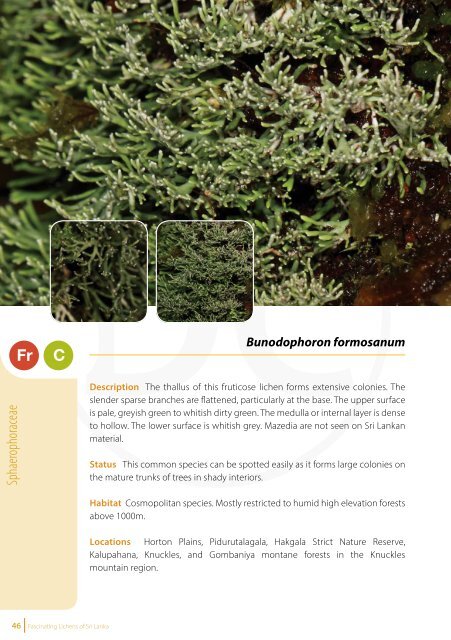Create successful ePaper yourself
Turn your PDF publications into a flip-book with our unique Google optimized e-Paper software.
Cladonia<br />
Reindeer lichens, Caribou lichens, Reindeer moss<br />
Lecanorales Cladoniaceae<br />
350<br />
Cladonia is a large lichen genus and widely distributed in both hemispheres. A<br />
number <strong>of</strong> species are cosmopolitan, typically favouring sunny habitats, but a<br />
few occur in shady forest interiors. Most commonly found on soil but occur on<br />
all kinds <strong>of</strong> substrates. It is especially abundant on sandy soil, exposed acid rock<br />
outcrops, dead wood in rather dry situations, eucalyptus and pinus forests and<br />
at forest margins.<br />
Several species are widespread in <strong>Sri</strong> <strong>Lanka</strong>, but are <strong>of</strong>ten misidentified due to<br />
their complex morphology and chemistry. Few recent collections were studied<br />
recently by Gothamie Weerakoon and Andre Aptroot. Twelve new records <strong>of</strong><br />
Cladonia were discovered for <strong>Sri</strong> <strong>Lanka</strong> including 4 species that are new records<br />
for the Indian subcontinent (Weerakoon & Aptroot 2014). It is possible that many<br />
undiscovered species occur in particular montane communities. The species<br />
form extensive colourful lawns on the forest floor and in open stony areas.<br />
Sphaerophoraceae<br />
Fr<br />
C<br />
Bunodophoron formosanum<br />
Description The thallus <strong>of</strong> this fruticose lichen forms extensive colonies. The<br />
slender sparse branches are flattened, particularly at the base. The upper surface<br />
is pale, greyish green to whitish dirty green. The medulla or internal layer is dense<br />
to hollow. The lower surface is whitish grey. Mazedia are not seen on <strong>Sri</strong> <strong>Lanka</strong>n<br />
material.<br />
Status This common species can be spotted easily as it forms large colonies on<br />
the mature trunks <strong>of</strong> trees in shady interiors.<br />
The species in this genus have a complex morphology. The development <strong>of</strong><br />
the lichen thallus begins with a scaly (Squamulose) primary thallus. Next, erect<br />
stalks or podetia develop from the surface or the edge <strong>of</strong> the squamules. In<br />
some species, the primary squamules disappear leaving the podetia. Podetia are<br />
hollow, simple or branched, can end in a cup-like structure or be tapered or have<br />
a pointed tip.<br />
The end <strong>of</strong> Podetia produces brown or bright red (sometimes waxy yellowish<br />
beige) biatorine apothecia (disc) containing colourless, single celled spores, 8<br />
per ascus.<br />
Chemistry Contains wide variety <strong>of</strong> compounds.<br />
Cladoniaceae<br />
Habitat Cosmopolitan species. Mostly restricted to humid high elevation forests<br />
above 1000m.<br />
Locations Horton Plains, Pidurutalagala, Hakgala Strict Nature Reserve,<br />
Kalupahana, Knuckles, and Gombaniya montane forests in the Knuckles<br />
mountain region.<br />
46 <strong>Fascinating</strong> <strong>Lichens</strong> <strong>of</strong> <strong>Sri</strong> <strong>Lanka</strong><br />
<strong>Fascinating</strong> <strong>Lichens</strong> <strong>of</strong> <strong>Sri</strong> <strong>Lanka</strong> 47















